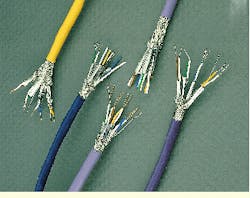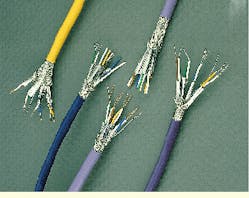Patrick McLaughlin
For a medium that does not represent a significant portion of the North American premises cabling market, shielded twisted-pair (stp) cable has been the topic of much conversation lately. In fact, if you consider the sometimes vexing nomenclature associated with shielded cabling and the imminent standard that will cover one type of the medium, you may conclude that professionals in the premises cabling industry are talking about shielded cabling a lot more than they are actually installing it.
For many, the talking begins when they are identifying what type of stp cabling they are dealing with.
Ned Sigmon, associate director of technical marketing at amp Inc., explains the three types. "There`s the 150-ohm cable, commonly called the ibm cabling system. It has two individually shielded pairs.
"Then there are two 100-ohm shielded cables. One has the same impedance as unshielded twisted-pair (utp) cable and has individually shielded pairs. It also has an overall shield that covers all the pairs." This type is typically referred to as stp in the United States, and pimf (pairs in metal foil) in Europe. It is also called sstp (shielded screened twisted pair) by some. Sigmon points out that the term "stp" has been used liberally in the United States, and is generally associated with 150-ohm cable here. It has also been loosely used to refer to any cable with a shield. He also notes that in Europe, the same term--stp--has been used in the past to refer to basically anything that had individually shielded pairs. He says the term "pimf" has emerged in recent years and distinguishes 100-ohm individually shielded-pair cables from other types, such as 120 and 150 ohm.
"The third category, also 100 ohms, is like utp but includes one overall shield, as opposed to the individually shielded pairs." This type is commonly called sctp (screened twisted-pair), but is also called ftp (foiled twisted-pair).
According to Sigmon, sctp is the simplest and lowest-priced of the three. He says the single overall shield is present to control either the emissions radiating from the cable or the noise coming into it. "Its transmission performance is the same as utp," he says. "In fact, you`ll find it listed in the same categories--3, 4, and 5--as utp."
sctp standard under development
Sigmon chairs the Telecommunications Industry Association (tia--Arlington, VA) task group that is currently developing a standard covering sctp cable. He estimates that the standard will be issued in early to mid-1998, and expects it to establish measures that will quantify sctp products` shielding effectiveness.
"We`ve attempted to come up with absolute figure-of-merit measures of components by themselves so users can be assured that the individual components have certain minimum shielding-effectiveness characteristics," he says. "That is intended to some day lead to a situation in which users can mix and match components from different manufacturers and be assured of at least a minimum performance. That`s the whole idea of standardization."
The development of this standard marks a maturation point of sorts for sctp cable. Sigmon explains one widespread practice that underpins the need for a standard. "The typical method to test a system`s shielding characteristics has been to test its shielding characteristics, then cut the cable, put a connector on it, and see what the difference was. It was relative, with no means for an absolute measurement."
To this point, a user`s best assurance of adequate shielding performance was to purchase a cabling system from a single vendor (see Product Update table on page 34). As Sigmon points out, the soon-to-be-released standard should pave the way to eventual interoperability among shielded components.
Manufactured for specialized environments
Shielded cabling does have attributes that allow its use in some applications in which utp cable would not suffice. Jay Lahman, manager of copper products at Thomas & Betts, says, "Shielding is preferable in certain environments, such as where there is high noise and where electromagnetic interference (emi) or radio-frequency interference (rfi) are considerations." He says these conditions exist in data-sensitive areas, including hospitals and military and aerospace plants. "Shielding provides protection, not only from external noise, but also internally among the pairs and from energy radiating into the environment."
Lahman says his company`s all-lan shielded twisted-pair system, which includes cable, connectors, patch panels, cable assemblies, and information outlets, achieves positive attenuation-to-crosstalk ratio to 300 megahertz. This differs, he says, from many utp cables claiming performance at high frequencies. "Some utp cables may be tested to 350 or 400 MHz, but there`s no usable bandwidth at that frequency. Some of the characteristics that the enhanced utp manufacturers have been touting have been performed for years by shielded cable." He stresses, however, that this performance can be achieved by sstp/pimf cables and probably not by sctp cables.
Mark Johnston, director of technology development for cable-tester manufacturer Microtest Inc. (Phoenix, AZ), provides support for sstp`s low near-end crosstalk. "We use that type of patch cord with our PentaScanner because it basically has zero crosstalk." He also says that when a Category 6 cable is introduced, it will be shielded.
Joe McGowan, copper business manager with Berk-Tek, an Alcatel Co. (New Holland, PA), agrees. "Category 6 cable will certainly be shielded in some configuration. It probably won`t be as rugged as the pimf design, but it will probably have an overall foil braid, foil shield, or perhaps a shielded-braid configuration. In any case, it will have to be shielded to be able to get up into high-frequency range in real operation."
McGowan also says that Europeans, particularly Germans, tend to install shielded cabling more than do North Americans. "Germans look for robust cables, including shields, braids, foils, and individually shielded pairs. They look for the most robust cable and the highest performance they can get."
Johnston offers more insight into Germany`s abundant use of shielded systems. "The German culture is extremely environmentally conscious," he says. He adds that, when you consider the country`s strict environmental laws, including mandatory recycling and restrictions against personal gasoline-powered boats, it is not difficult to understand why so much shielded cable is installed to protect against electronic emissions.
He also points out an eye-opening reality for German corporations. "If you work in an office environment and you develop a disease or other health challenge, and it can be shown or suggested that the problem is due to cabling emissions, and the cabling is unshielded, then your employer--not your insurance company--is responsible for your medical costs. If the cabling is shielded, no legal liability exists."
The potential for such financial liability goes a long way toward explaining why the use of shielded cable in Germany far outweighs its use in North America. From a hands-on perspective, utp is easier to work with. It is also more affordable. "Very few of our clients are specifying shielded cable," says Dan Ameruoso, executive vice president of lan1 (Hawthorne, NY), a network-design firm. "utp is less expensive and easier to work with. That appeals to both the client and the installer." He says on average, he works with fewer than five clients per year that specify shielded systems.
The manner in which shielded systems are grounded and bonded has also given the product line something of a bad name. As Thomas & Betts`s Lahman points out, improper grounding negates all benefits of a shielded system. "If you`re not grounding properly, you might as well be running utp," he says.
Sigmon, who believes the grounding issue has been somewhat overblown, says the upcoming standard will address grounding. "There has been a lot of concern as to whether these systems should have one point of ground in the shield, or two or more points. There has also been concern over ground-loop problems. We have attempted to clarify the situation and provide guidelines on how the shield should be grounded during installation."
Future: bright or bleak?
An emergence of shielded cable into North American networks may depend on the actions of other parties. If, as predicted, Category 6 cable is shielded, the presence of shielded products almost assuredly will increase. Lahman says that the Federal Communications Commission (fcc--Washington, DC) can also have a significant impact. fcc regulations monitor signals transmitted above 30.5 MHz. Lahman says, "At some point, the fcc may ask exactly what is going on at these higher frequencies. It may investigate whether the environment and office equipment are susceptible to data being transmitted at higher frequencies."
Johnston says there are three scenarios that could prompt increased use of shielded systems. "For shielded systems to be successful in North America, I think there is either going to have to be a network technology in demand that can`t be supported on utp, increased concern on the fcc`s part, or parity with utp and fiber in terms of cost."
Fiber`s strong showing in the market is yet another hindrance to shielded cable`s progress. McGowan notes that Germany--the country with such emissions concerns--has a high percentage of fiber-to-the-desk. Lahman adds, "If the price of optoelectronic hardware comes down to the point where it costs the same as or slightly more than its copper counterparts, then I think people will go directly to fiber-to-the-desk."
Shielded cable manufactured by Montrose/cdt is part of Thomas & Betts`s all-lan shielded cabling system.

